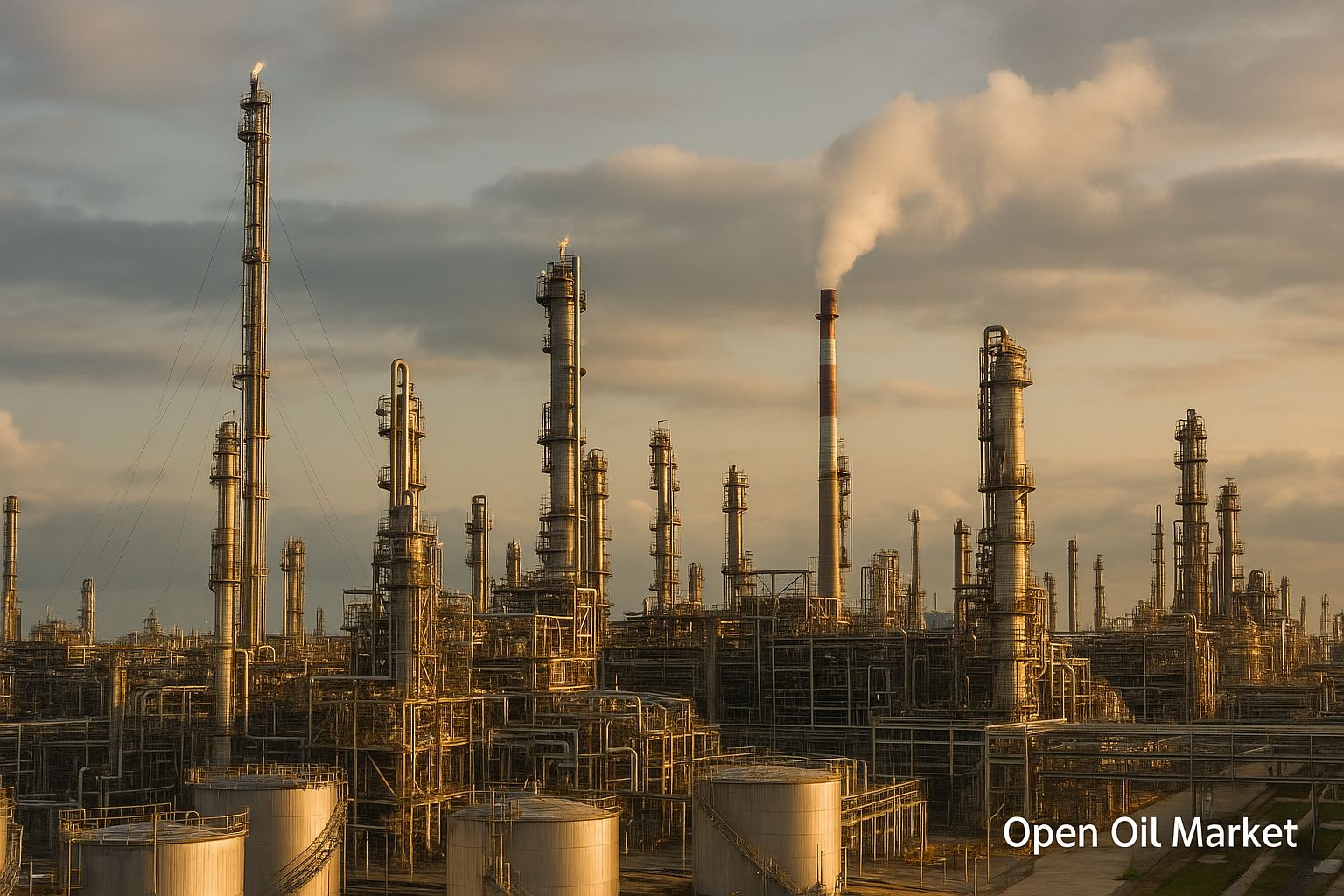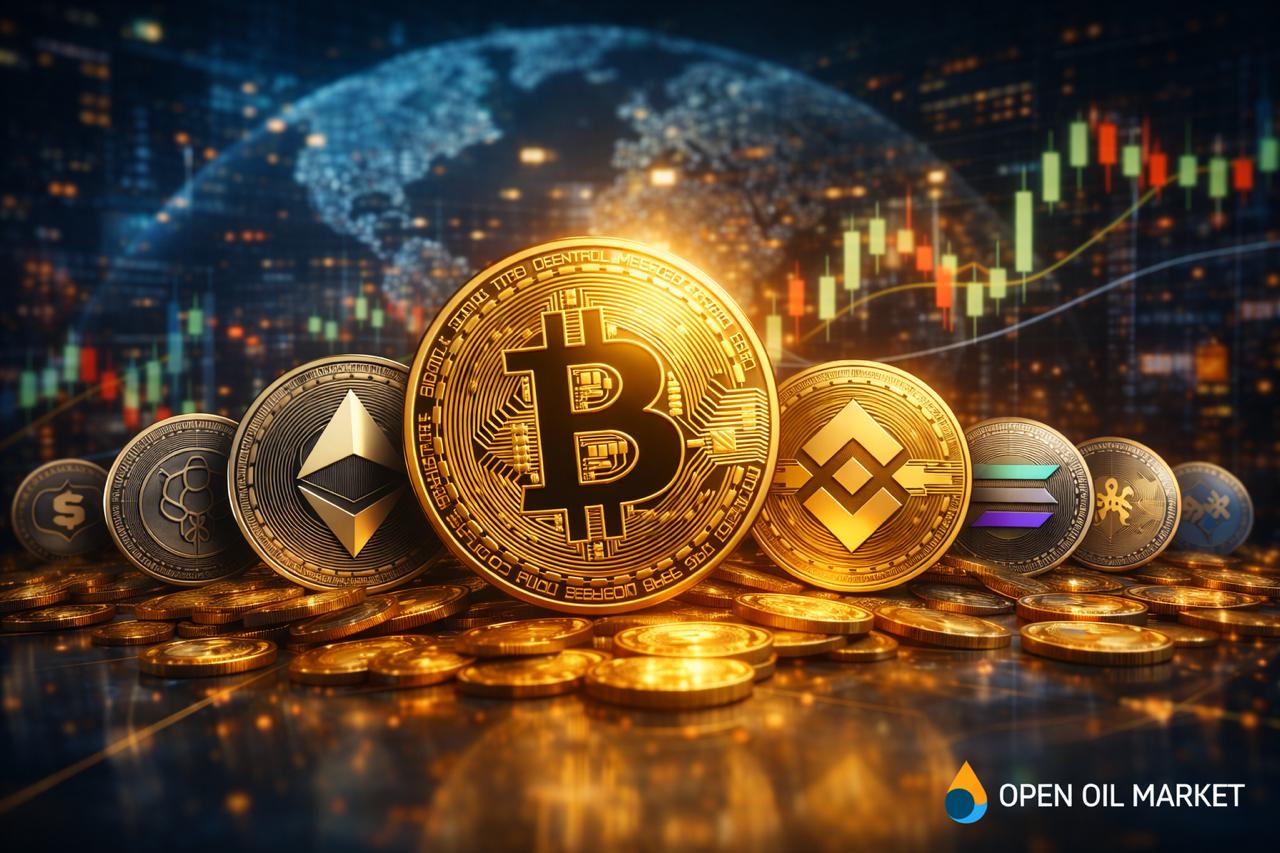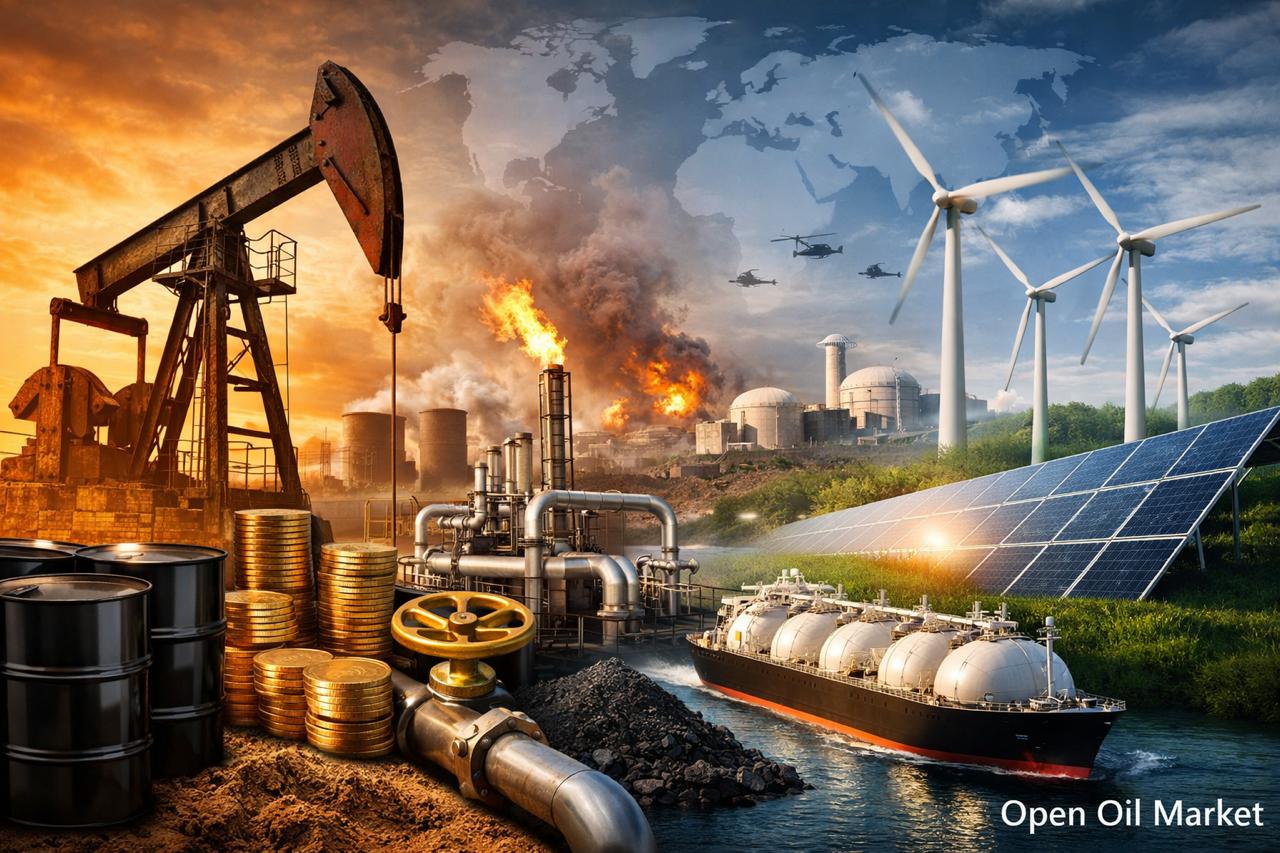
Current Energy Sector News for Thursday, October 16, 2025: Oil at Price Lows, Stable Gas Market, Continuation of Sanction Pressure, and Outcomes of the Energy Forum. Analysis by Open Oil Market.
As of mid-October 2025, the global fuel and energy sector presents a relatively stable yet ambiguous picture. Oil prices remain near multi-month lows amid expectations of an oversupply by year's end, while the geopolitical standoff between Russia and the West shows no signs of easing. Sanction pressure on the Russian energy sector continues to intensify, with the United Kingdom implementing new restrictions against Russian companies and its tanker fleet, thereby maintaining the overall sanction front and keeping Russian exports under pressure.
Simultaneously, Europe is heading into winter with unprecedented gas inventories, which provides price stability in the market unless extreme cold weather occurs. The global energy transition is gaining momentum, with record investments in renewable energy, though traditional resources still play a vital role as a safety net. In Russia, emergency measures to stabilize the domestic fuel market are already yielding results—fuel shortages are decreasing, and wholesale prices are retreating from their peaks. The ongoing International Forum "Russian Energy Week 2025" (October 15–17) in Moscow is focusing on ensuring the domestic energy market's stability and redirecting exports under new sanction conditions. Below is an overview of key events and industry trends as of October 16, 2025, significant for investors, market participants, and oil and gas companies.
Domestic Fuel Market: Normalization and Market Support
After the acute fuel crisis in September, the situation in the domestic oil product market is gradually normalizing. In most regions of Russia, gasoline shortages have been eliminated: wholesale prices have significantly retreated from record highs, and uninterrupted fuel sales have resumed at independent gas stations. However, supply remains tight in areas far from major refineries (the Far East and some Siberian regions)—the authorities are keeping the situation under control by extending restrictions and implementing new market support measures.
- Emergency Measures and Imports: The Russian government has extended the temporary ban on automotive gasoline exports until December 31, 2025, and maintained restrictions on diesel fuel exports for independent suppliers until the end of the year. These steps allow for the redirection of maximum fuel volumes to the domestic market. Simultaneously, attracting external resources is being considered: discussions are underway regarding temporarily removing import duties to facilitate gasoline and diesel imports (for instance, from Belarusian refineries) to meet the needs of remote regions.
- Price Control and Dampers: As of October 1, a moratorium on the removal of the fuel damper has been introduced—the state continues to compensate oil refineries for domestic market supplies, even if exchange prices exceed threshold levels. This move maintains economic incentives to direct gasoline and diesel to gas stations within the country. Concurrently, the Federal Antimonopoly Service and the Ministry of Energy have tightened price monitoring: several gas station networks have received warnings for unjustified price hikes. Although direct state regulation of retail prices is being avoided, targeted market support mechanisms are being proposed instead of price freezes.
- Initial Outcomes: By mid-October, the deficit of motor fuel in the country has significantly decreased. The completion of unscheduled repairs at oil refineries and the redirection of export volumes to the domestic market have allowed for increased wholesale shipments to the most affected regions. In central and southern areas, gasoline and diesel inventories at depots and stations are returning to normal levels. The government aims to navigate the upcoming winter period without serious supply disruptions, although the situation requires continuous monitoring and readiness for additional interventions if necessary.
Commentary. The government's actions to stabilize the market have been timely and necessary, notes Sergey Tereshkin, CEO of the Open Oil Market platform. According to him, maintaining damper payments at high prices and strict export restrictions helped saturate the domestic market and alleviate the severity of the crisis. Going forward, besides manual regulation, the industry requires systematic infrastructure development—including the implementation of digital platforms for wholesale fuel trading—to enhance transparency in resource distribution across regions and prevent the recurrence of similar situations in the future.
Oil Market: Price Lows, Excess Supply, and Sanction Risks
Global oil prices in the second decade of October are holding at their lowest levels in recent months. The benchmark Brent crude is trading around $62–64 per barrel, while the American WTI is at $58–60, significantly below this year's highs (around $80 in spring). The market is pricing in an oversupply scenario by the end of 2025, thus keeping quotations under pressure, despite a brief increase a month earlier.
- Supply and Demand Balance: OPEC+ countries are executing a plan for a gradual increase in production. At the October 5 meeting, the alliance confirmed a collective quota increase of approximately +130–140 thousand barrels per day starting in November, continuing its cautious return to lost market shares. Concurrently, global oil demand is rising more slowly than anticipated. The International Energy Agency, in its October report, has downgraded its demand growth forecast for 2025 to around 710 thousand barrels per day (from previously expected ~740 thousand), citing slowdowns in European and Chinese economies. OPEC is also expecting modest growth (~+1.2 million barrels per day), while production outside of OPEC (especially in the US, Brazil, and Guyana) is increasing at an accelerated pace. As a result, analysts warn about the likelihood of oil oversupply in the global market in Q4, thereby keeping prices at the lower boundary.
- Sanctions and Geopolitics: Western sanctions remain a critical uncertainty factor for the oil sector. Earlier this year, a reduction in the price cap on Russian oil to $47.6 per barrel came into effect (as part of the 18th package of EU sanctions), and new restrictions are now under discussion. Washington is urging allies to completely stop purchases of Russian oil and to close schemes for circumventing sanctions through a "shadow fleet" of tankers. Any tightening of the sanction regime could reduce the available supply in the global market and trigger a new wave of price volatility—especially if it coincides with other risk factors. Additional nervousness is sustained by international conflicts: despite a temporary de-escalation in the Middle East, the situation in the region remains unstable, along with the ongoing armed conflict in Ukraine. Recent drone attacks on oil infrastructure (including a fire at an oil depot in Crimea) highlighted the vulnerability of supplies. Thus, the geopolitical premium has not entirely disappeared and may again elevate quotations should the situation worsen.
- New Markets: Despite unprecedented sanctions, Russia has managed to maintain the majority of its oil exports by redirecting shipments from Europe to other destinations. **India** and **China** have significantly increased their purchases of Russian oil at discounted prices; traders estimate that around 30% of India's oil imports are now provided by Russian barrels. The flow of supplies to **Turkey**, Middle Eastern countries, and **Africa** is also increasing. This redirection supports revenues for the Russian energy sector and partially balances the global market, although it requires significant discounts and more complex logistics. In the event of further sanctions escalation (e.g., the introduction of secondary measures against carriers or buyers), these alternative sales channels may narrow, presenting a new challenge for the Russian oil industry.
Natural Gas: Record Inventories, Price Stability, and Export Realignment
The global gas market situation ahead of winter is favorable for consumers. The European Union is entering the heating season with record gas reserves: underground storage across the EU is filled to over 95% of maximum capacity—significantly higher than last autumn's levels. Thanks to mild weather and high supplies of liquefied natural gas (LNG), Europe has managed to create a solid "safety cushion" without emergency purchases, compensating for the sharp decline in pipeline supplies from Russia. Wholesale gas prices remain at relatively low levels: the Dutch TTF hub is trading in the range of ~30–35 €/MWh, which is several times lower than peak levels in the autumn of 2022. With moderate demand this autumn, the market remains stable, significantly reducing the risks of a repeat of last year's price crisis.
- Europe's Withdrawal from Russian Gas: European countries continue to pursue a rapid reduction in dependence on Russian gas. Direct pipeline supplies from Russia have fallen to nominal volumes and remain only with a few countries (such as Hungary) under long-term contracts. The EU plans to legally enshrine a complete withdrawal from Russian energy carriers in the medium term: the draft of the 19th sanctions package discusses a ban on imports of Russian LNG by 2026–2027. Already, Russia's share in the EU gas import structure has decreased from ~40% to less than 15% over the last two years, and in the coming years, imports from Russia could be reduced to zero.
- Moscow's Eastern Turn: Having lost most European markets, Russia is increasing gas exports to the East. Supplies through the "Power of Siberia" pipeline to China continue to increase and could reach record levels of ~22 billion m3 in 2025—close to the pipeline's design capacity. Concurrent negotiations are underway for the construction of a second phase of the pipeline through Mongolia ("Power of Siberia 2"), which by the end of the decade will partially replace the volumes lost from Europe. Additionally, Russia is expanding LNG exports, launching new liquefaction projects in Yamal and the Far East. Additional batches of Russian LNG are already being directed to India, China, Bangladesh, and other countries. However, in the short term, total gas exports from Russia remain below pre-sanction levels—Moscow's priority is currently the domestic market and meeting the needs of its CIS partners.
Power Sector: Record Consumption and Network Upgrades
Global electricity consumption in 2025 continues to set historical records. Economic growth, the development of digital technologies, and widespread electrification of transport are driving demand for electricity across all regions of the world. According to industry analysts, the total global electricity generation this year is expected to exceed 30,000 TWh for the first time—an unprecedented level. Major economies are contributing the most: the **US** is expected to consume around 4.1 trillion kWh (a new record for the country), while **China** anticipates over 8.5 trillion kWh. The energy consumption in developing countries across Asia, Africa, and the Middle East is also rapidly increasing due to industrialization and population growth.
- Network Strain: The rapid growth in electricity consumption requires proactive upgrades to infrastructure. Many countries have announced large-scale investment programs aimed at expanding and modernizing their energy systems, as well as building new generating capacities—to prevent energy shortages and outages during peak loads. For instance, in the US, energy companies are investing billions of dollars to strengthen distribution networks against the increased load from data centers and electric vehicle charging stations. Similar projects to enhance energy networks are being implemented in Europe, China, and India. Concurrently, the role of smart grids and energy storage systems is increasing: industrial battery farms and pumped storage stations will help manage loads flexibly and integrate the growing power generation from renewable sources.
Renewable Energy: Record Investments, Support, and New Challenges
The renewable energy sector (RES) in 2025 is demonstrating impressive growth, continuing the global trend toward "green" transformation in the energy sector. Investments in solar and wind energy, as well as related clean technologies, are hitting record highs. In the first six months of 2025 alone, approximately $400 billion was invested in RES projects worldwide—10–12% more than in the same period last year. These funds are primarily directed toward the construction of new solar and wind power plants, creating energy storage systems, and the digitalization of networks to integrate distributed generation. The massive commissioning of new capacities allows for an increase in electricity production without raising greenhouse gas emissions.
- Share of Clean Energy: Renewable sources are occupying an increasingly significant position in the global energy balance. On average, around 30% of electricity generation worldwide is now provided by RES. In the European Union, this figure has exceeded 45% due to active climate policies and the closure of coal-fired power plants. **China** is approaching the milestone of 30% generation from RES, despite the enormous size of its energy system and the continued construction of new coal-fired plants. For the first time in 2025, the global volume of electricity generation from solar and wind has exceeded that from coal—an important symbolic milestone for the energy sector.
- Government Support and Initiatives: The governments of major economies are intensifying support for green energy. In Europe, new climate targets have been adopted, requiring accelerated deployment of clean capacities and the development of carbon quota trading. In the US, measures to stimulate RES and related sectors continue to be implemented (tax breaks and subsidies under the Inflation Reduction Act). Initiatives are also being launched in CIS countries: Russia and Kazakhstan are holding RES auctions to select solar and wind projects, while Uzbekistan is building large solar parks in desert regions. This support aims to reduce industry costs and attract new investments, accelerating the transition to clean energy.
- Growth Challenges: The rapid growth of RES is accompanied by a series of challenges. High demand for equipment and raw materials (e.g., polysilicon for solar panels) is driving up project costs and putting pressure on supply chains. The sector is also facing a shortage of skilled labor to construct and operate hundreds of new facilities worldwide. Furthermore, energy systems require high flexibility: integrating large volumes of variable generation necessitates accelerated development of energy storage systems and intelligent load management. Despite these challenges, the global course towards decarbonization remains intact, with expectations of further investments in RES and new records in the share of clean energy in the energy sector.
Coal Market: Asian Demand and Gradual Coal Phase-Out
The global coal market in 2025 is characterized by mixed trends. In several Asian countries, demand for coal remains high and is even increasing in some areas. This summer saw a surge in thermal coal imports in East Asia: for example, in August, **China**, **Japan**, and **South Korea** collectively increased purchases by nearly 20% compared to the previous month. Internal factors have played a role: in China, due to intensified environmental checks and safety requirements, coal production was temporarily reduced, while industrial energy consumption was rising rapidly. China compensated for the lost generation by increasing coal imports, which raised regional prices: Australian Newcastle coal exceeded $110 per ton (a maximum for the past five months). Similarly, **India** and other developing economies have increased coal consumption to support stability in their energy systems during peak periods.
However, the long-term outlook for the coal industry remains unfavorable. More countries are adhering to coal phase-out policies for environmental goals and emission reductions. The share of coal generation in the EU has fallen below 10% (compared to around 15% a few years ago), with 11 EU countries intending to close all coal-fired power plants by 2030, replacing them with gas and renewable capacities. In the US, despite targeted support measures for coal producers, market conditions are also unfavorable for coal: cheap natural gas and rapid growth in RES continue to displace coal from the energy mix. Even countries traditionally dependent on coal are reducing its usage—Germany, after a temporary increase in coal consumption in 2022–2023, is again cutting electricity generation from coal-fired plants in 2025.
- Export Reorientation from Russia: For Russia, one of the world's largest coal exporters, global trends mean a shift in primary sales markets. Following the EU embargo in 2022, Russian coal companies have redirected shipments to Asia. Currently, more than 75% of Russia's coal exports are destined for **China**, **India**, **Turkey**, and other Asia-Pacific countries. This demand partially compensates for the loss of the European market, although trading with distant countries necessitates discounts and increases logistics costs. In the long run, as major world economies increasingly phase out coal, Russian coal producers will need to adapt—exploring new markets and enhancing efficiency to remain competitive.
Forecasts and Perspectives: Cooperation at the Forum and Winter Risks
Overall, the energy sector is approaching the end of 2025 in a state of adaptation to new realities. The sanction standoff between Russia and the West continues to reshape global energy resource trading. Fuel and energy companies are seeking ways to mitigate risks and explore new niches—whether through redirecting exports to Asian markets or increasing deep processing of raw materials domestically. Simultaneously, the global energy transition is gaining momentum: record investments in RES and energy efficiency are shaping the long-term configuration of the sector. The coming months will determine how successfully the sector navigates winter challenges and maintains a balance of interests during this complex phase of 2025.
The International Forum "Russian Energy Week" (REN-2025) taking place in Moscow from October 15–17 under the slogan "Creating the Energy of the Future Together" has become an important platform for discussing current challenges and prospects. Participants are focused on ensuring the stability of the domestic energy resource market and realizing Russia's export potential under new conditions. Within the forum, energy dialogue "Russia-OPEC" is taking place, with particular emphasis on strengthening cooperation between Russia and Asian and African countries in the energy sector. New agreements and partnerships aimed at developing the fuel and energy sector and expanding international cooperation are expected to be reached during the forum. The outcomes of the meeting of industry leaders will set the tone for future reforms and investments.
In conclusion, investors and energy market participants are closing the year with cautious optimism—as adaptation to new conditions continues, and the energy sector demonstrates resilience and readiness for change.




